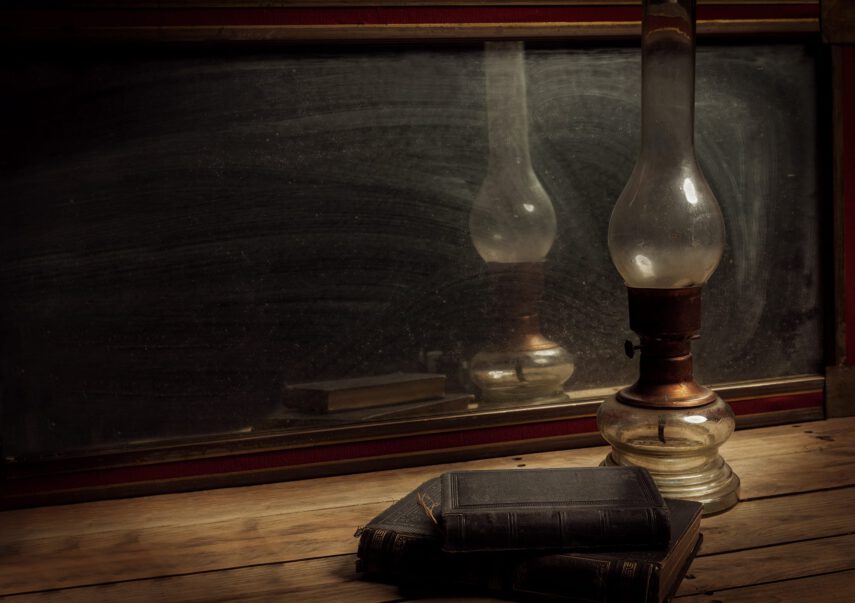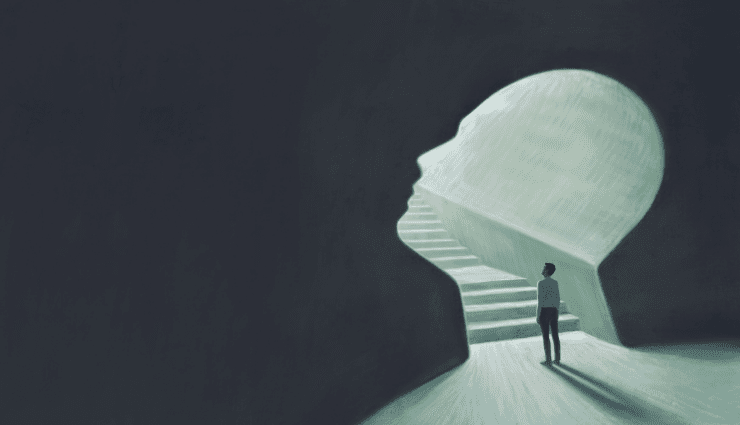Mirror or Lamp

Dear Friends and Colleagues in Catholic Education:
I have had the distinct privilege of serving as trusted advisor and search consultant to dozens of Catholic schools and dioceses across the country. In this capacity I have had the honor of counseling boards, bishops, and search committees on matters of great strategic importance to their schools and have met in confidence with numerous parents and students to fathom the culture, anxieties, and aspirations of these institutions. While I remain enormously excited about the future of our Catholic schools, I am writing to share a concern of increasing urgency and sensitivity.
Bear with me while I provide some context for my thinking and then offer what I hope will be a respectful ideological framework for addressing these concerns.
Many years ago, as an eager graduate student of British and American Literature, I read a book of literary criticism by noted Cornell professor M.H. Abrams entitled, “The Mirror and the Lamp.” It was one of the most influential studies I have ever read, and its wisdom finds its way into my unsuspecting consciousness even today. In this remarkably erudite and persuasive tome, Abrams traces the evolution of literary practices and sensibilities from the 18th century Neo-Classical period to the 19th century Romantic period − from the likes of Dryden, Pope, and Swift to Coleridge, Blake, and Wordsworth. For purposes of this connection, it matters little whether one is familiar with any of these writers or the underlying aesthetic inspiring their verses. What matters is Abrams’ insightful notion that 18th century literature was typically viewed as being “mimetic” – i.e., like a mirror held up to reality − whereas for the 19th century Romantics, literature was more akin to a lamp, illuminating the soul and sensibility of the writer, and revealing rather than reflecting reality. He referred to the mirror and lamp as “constitutive metaphors” because of the enormous organizing powers they demonstrated in understanding the radical shift in emphasis between the two periods.
Don’t ask me how or why, but recently I found myself reflecting on these constitutive metaphors as I discerned the disturbing confrontational tragedies playing out in our Catholic schools today. As I trust you are aware, in numerous communities and dioceses across the country we are witnessing an unprecedented collision of values as our American civil liberties confront the established teachings of the Church, especially concerning homosexuality and same sex marriage. At diocesan as well as independent Catholic schools, young children are being denied access to our schools because of the “objectionable behaviors” of their adult parents, faculty and staff who are outed on social media and other sites are escorted off campus without due process, and school heads who resist enforcing the rules are fired and effectively blackballed as Catholic school leaders.
Please know, I am not questioning for a moment the Church’s right to enforce its principles and cherished values, and I certainly support the good bishops and Church leaders attempting to hold the line against the insidious coarsening of our culture and the increasing secularization of our society. I can only imagine how frustrating it must be for our bishops to be standing alone, confronting the enveloping threats to our Catholic values and traditions. I can picture the solitary and venerable King Canute standing on the shoreline, arms outstretched, and commanding the tides not to come in − only to be swamped by the powerful advancing forces beyond his control. And so it goes with many of our earnest bishops and church leaders as well. The barbarians are indeed at the gate!
But I do find myself wondering why this ad hominem drama needs to occur on the campuses and playgrounds of our Catholic schools. Why are our schools suddenly ground zero for these no-win moral skirmishes? And where does it say that our Catholic schools need to serve as enforcement vehicles for Church teachings? This strikes me as a needless lose-lose scenario for the Church and our Catholic schools, as witnessed by the massively unfavorable press we are receiving and the torment and dissidence playing out among our school communities.
Some would argue that regardless of the widespread opprobrium and reputational risks to our schools, the Church has no choice in these matters, and that being a “Catholic” school requires strict compliance with the teachings of the Catholic Church − a zero tolerance, if you will. Some call it common sense. But I wonder if this is necessarily true. Without seeming impudent, I wonder if we are not needlessly trapped in an ideological quandary of our own making.
In short, I wonder if we are embracing the wrong constitutive metaphor for our time?
—————————————————————-
Indulge me while I engage in an extended thought exercise and see where this takes us. I begin by asking an elemental question:
What is the true and proper relationship between Catholic schools and the Catholic Church?
Borrowing from Abrams, are Catholic schools mirrors or lamps in what they disclose to us about the Church? Do they reflect or reveal?
If Catholic schools are expected to serve mimetically as “mirrors” to the Church, as is the current practice of some bishops and church leaders, then they clearly must faithfully reflect Church teachings and would be expected to serve as instruments for compliance and strict enforcement of beliefs. The current detection and enforcement practices would remain in place, creating further headlines and heartbreak but serving their purposes faithfully nonetheless.
On the other hand, if Catholic schools could be viewed appropriately as “lamps” of the Catholic Faith, illuminating and revealing (in a Platonic sense) what is best in our religion and Catholic culture, then they could be considered evidentiary fragments of the faith, symbolic of the Church’s fundamental goodness and grace, and thereby welcoming vehicles for such worthy pursuits as evangelization, respectful dialogue, inclusive community, and social justice.
Here it may be helpful to make a distinction between the Catholic Church as an ecclesial institution and the Catholic Church as our source of faith and inspiration. As an institution, the Catholic Church is human, all-too-human, and thereby a flawed guiding construct. As inspiration, the Catholic “Faith” is foundational and the source of our highest ideals and values such as concern for the poor, inclusive community, and social justice. Our Catholic “institution” has given us flawed anecdotal standards and shameful priestly abuse. Our Catholic “Faith” has issued forth the beautiful and lucid founding charisms of the Benedictines, Jesuits, Lasallians, Mercies, Dominicans, and Franciscans, to name just a few.
In short, it would seem appropriate in the context of Abrams’ proposition to view the Church as mirror and our Faith as lamp. The question is, how do we advance from one to the other? How do we achieve the “radical shift in sensibility” expressed above?
If we could flip the constitutive metaphor from mirror to lamp, we would instantly change the school culture and climate and transition seamlessly from battle ground to sacred ground, and from mirrors of detection and enforcement to lamps of enlightenment. Tolerance would replace judgment as the dominant ethos of our learning corridors. Equally important, our bishops and other Church leaders would be liberated from their current enforcement burdens and could focus on their more rewarding duties as pastors and shepherds to the faithful.
Admittedly, this would represent a major perceptual shift in the relationship between our Catholic schools and the Church, a near-Copernican pivot in the way we view these alignments. The center of gravity shifts dramatically. From a practical point of view, it would also create a significant policy change for many of our Catholic schools. The accountabilities and management practices of a tolerant school environment inspired by the lamp as constitutive metaphor would be more amorphous and complicated − but Catholic schools have dealt with this kind of messy ambiguity before, and quite effectively. Non-Catholic students and faculty have been welcomed into Catholic schools for decades and have been encouraged to participate in Catholic rites and liturgies as respectful members of the community. Since they are not practicing Catholics, they are not allowed to participate in the sacramental life of the Church, but they attend and give witness and grow in their own faith journey as a result.
Surely we can find a way, consistent with our Catholic traditions, to manage a nuanced school environment built on a kind of respectful equipoise, where we neither condemn nor condone but speak passionately and frankly about the things we value and allow all within hearing distance to internalize and discern according to their own beliefs. No trigger alerts or safe spaces. We would remain the host institution, completely in control of what gets taught and how as well as the rules of engagement including employment agreements, enrollment contracts, and family engagement practices. The risks would seem minimal but the upside potential immense. The Miami school teacher whose same-sex marriage was recently outed on Facebook would not necessarily lose her job and be banished from the community − as occurred − but would potentially forfeit access to the sacraments as an erstwhile Catholic no longer in good standing with the church. Going forward, she would be evaluated as a teacher on the quality of her work and her contributions to the school community. This would be Catholic jurisprudence at its best – not a fast track to perdition and shame but compassionate and proportional consequences built on a shared alignment of expectations.
—————————————————————-
Perhaps not surprisingly, this collision of values is escalating at precisely the time when our Catholic schools in America − especially high performing, independent Catholic schools − have been emerging in recent years as the educational institutions of choice for families of all faith traditions, Catholic and non-Catholic alike. These high performing Catholic schools have flipped their fortunes, jujitsu-like, by elevating their leadership and governance practices and by converting demographic threats into opportunities. In the process they have raised their academic standards significantly and repositioned themselves as inclusive sanctuaries of faith and best practice. Today, on average, upwards of 35% to 40% of students in independent Catholic schools self-identify as “non-Catholic” and feel exceedingly welcomed and encouraged to grow in their own beliefs while attending Catholic school.
Ironically, Catholic schools are also benefitting from a fortuitous convergence of demographic trends in our country. The stars are aligning perfectly and in unexpected ways. According to Pew Research, American families across the faith spectrum are declining in formal religious affiliation. Only 22% of Americans self-identify as Catholic today, and that number continues to decline and may be approaching 19%. Other religions are experiencing even steeper declines. Offsetting this troubling trend, American families are holding strongly to their innate belief in a powerful transcendent reality. An abiding sense of spiritual wonder and zeal continues to enrich the American experience – for believers and non-believers alike. Families know in their hearts that there is more to life than getting and spending, and while they may be lazy and complacent in their own religious practices, they are caring adults who, more than ever, want a high quality, belief-centered educational experience for their children. And this is one of the reasons why Catholic schools have emerged of late as the institutions of choice for families of all religious beliefs.
Let me close with a brief story from a recent leadership search experience. Several months ago, I spent a couple of intense days on the campus of an all-girls Catholic school in the Midwest meeting with key constituents in preparation for the launch of a new Head of School search. This is a wonderful independent Catholic school with a beautiful founding charism promoting equity and inclusion, hospitality, and confident women leaders. Eight months prior to my arrival, the school had experienced a traumatic and high-profile collision of values over the issue of homosexuality, which resulted in the abrupt removal of the Head of School and a brutal social media blitz that divided the campus into warring factions. I met with more than a hundred key constituents during my visit including faculty, staff, parents, alumnae, and sponsoring religious nuns. Among the many questions I asked of each group was the issue of what they would most like to see in the qualities and characteristics of their next Head of School. The common sentiment from virtually every constituency went something like this:
“Don’t get us wrong, Bob. We love our school and we cherish our Catholic identity and ideals. But the Church has let us down, and we are hurting badly as a community. We need a healer-in-chief as our next leader, someone who can come in here and help us bind up our wounds and come together again as a community of love and mutual respect. This is a critical transition for us.”
The tears flowed freely in many sessions during those two soulful days − eight months following the original campus eruption that caused so much pain and divisiveness.
I worry about the future of our Catholic schools and what we are doing to our faithful families and children. This heartbreaking collision of values is likely to worsen and become even more prevalent as more and more diverse populations seek the unique gifts of a Catholic school experience for their children. It may be time for our Church prelates and sponsoring religious congregations to get out front of these looming threats and ask of each other the urgent existential question suggested throughout this piece:
Is it the mirror or lamp we choose to hold up to our Catholic schools?
Is this a question we dare ask? If so, do we have the courage, and the wisdom, to choose?
————————-END———————————–
Thank you for taking the time to read this timely piece. I realize this is a sensitive matter, and I hope my words give clarity and not offense. My goal is not to find fault or to lecture anyone on morals or the proper administration of justice but to see if we can find a way to frame this divisive conversation in a manner that will provide meaningful perspective on the right and true relationship between Catholic schools and the Catholic church while also providing our good bishops and other earnest Church leaders with a way to avoid these devastating lose-lose outcomes, if at all possible. We are all victims in this flawed arrangement. I look forward to hearing your thoughts and continuing to learn from each other.
Bob Regan is a former Senior Consultant with the CS&A Search Group’s Catholic Schools Practice.
Learn more about our Catholic Schools Practice and view current searches we’re running on our website.













